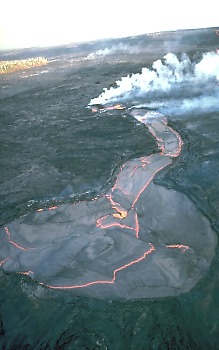VHP Photo Glossary: Lava lake
Lava lake
Lava lakes are large volumes of molten lava, usually basaltic, contained in a vent, crater, or broad depression. Scientists use the term to describe both lava lakes that are molten and those that are partly or completely solidified. Lava lakes can form (1) from one or more vents in a crater that erupts enough lava to partially fill the crater; (2) when lava pours into a crater or broad depression and partially fills the crater; and (3) atop a new vent that erupts lava continuously for a period of several weeks or more and slowly builds a crater higher and higher above the surrounding ground.
Image shows an aerial view of a lava lake atop the Kupaianaha vent on the east rift zone of Kilauea Volcano, Hawai`i. The fume rising from the end of the narrow part of the lava lake marks the beginning of a lava tube.
Did you know?
- Active lava lakes typically consist of a partially solidified shiny gray crust because its surface is constantly cooled by the atmosphere. The crust is seldom more than 5-30 cm thick, or more than a few minutes or hours old, because the crust continually circulates, breaks, and sinks into the moving molten lava below. The pattern of movement on the surface of lava lakes is often compared to the type of large-scale movement that occurs between the huge plates that make up the Earth's crust, including subduction, spreading, and strike-slip movement.
- Lava lakes occur at relatively few volcanoes in the world. For example, since 1980, lava lakes have formed at Kilauea Volcano in Hawai`i, Mount Erebus in Antarctica (involving rare phonolitic lava), Erta' Ale in Ethiopia and Nyiragongo in Zaire.


